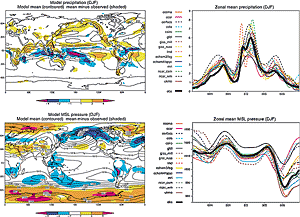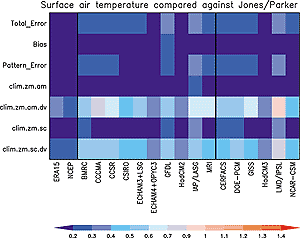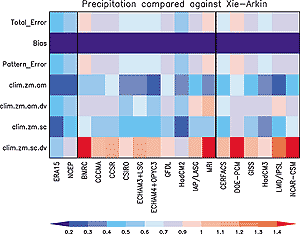8.5.1.2 Tropospheric climate
8.5.1.2.1 Surface quantities
The SAR’s evaluation of coupled-model simulations focused on surface air temperature,
sea level pressure and precipitation. The SAR concluded that model simulations
of surface air temperature were “very similar” to observations. Simulations
of the other two quantities were found to be less accurate but nevertheless
reasonable: the SAR concluded that coupled models represented “the observed
large-scale geographical distribution” of sea level pressure “rather well”,
and that they were “generally successful in simulating the broad-scale structure
of the observed precipitation”.

Figure 8.2: December-January-February climatological surface
air temperature in K simulated by the CMIP1 model control runs. Averages
over all models (upper left), over all flux adjusted models (lower
left) and over all non-flux adjusted models (lower right) are shown
together with zonal mean values for individual models (upper right).
Observed value is shown in the zonal mean plot (thick solid line),
and the difference between “average model” and observation is shown
on the longitude-latitude maps. From Lambert and Boer (2001). |
|

Figure 8.3: December-January-February climatological precipitation
in mm per day (top) and mean sea level pressure in hPa (bottom) simulated
by CMIP1 model control runs. Averages over all models are shown at
left and zonal mean values for individual models are shown at right.
Observed values are shown on the zonal mean plot (thick solid line)
and the difference between an “average model” and the observations
is shown by shading on the longitude-latitude maps. From Lambert and
Boer (2001). |
|
Figures 8.2 and 8.3 (reproduced from
Lambert and Boer, 2001) update this assessment using coupled model output from
the CMIP1 database. For each quantity, the figures show both a map of the average
over all fifteen models (“model mean”) and zonal means for all individual fifteen
models. Lambert and Boer (2001) demonstrate that the model mean exhibits good
agreement with observations, often better than any of the individual models.
Inspection of these portions of the figures reaffirms the SAR conclusions summarised
above. The errors in model-mean surface air temperature rarely exceed 1°C
over the oceans and 5°C over the continents; precipitation and sea level
pressure errors are relatively greater but the magnitudes and patterns of these
quantities are recognisably similar to observations. The bottom portion of Figure
8.2 shows maps of the model mean taken separately over all flux adjusted
models (lower left) and all non-flux adjusted models (lower right). Flux adjusted
models are generally more similar to the observations - and to each other -
than are non-flux adjusted models. However, errors in the non-flux adjusted
model mean are not grossly larger than errors in the flux adjusted model mean
(except in polar regions). This result from the “inter-model” CMIP database
suggests that the SAR was correct in anticipating that the need for flux adjustments
would diminish as coupled models improve. It is reinforced by “intra-model ensembles”,
i.e., by the experience that improvements to individual models can reduce the
need for flux adjustments (e.g., Boville and Gent, 1998).

Figure 8.4: Second-order statistics of surface air temperature, sea
level pressure and precipitation simulated by CMIP2 model control runs.
The radial co-ordinate gives the magnitude of total standard deviation,
normalised by the observed value, and the angular co-ordinate gives the
correlation with observations. It follows that the distance between the
OBSERVED point and any model’s point is proportional to the r.m.s model
error (see Section 8.2). Numbers indicate models counting
from left to right in the following two figures. Letters indicate alternate
observationally based data sets compared with the baseline observations:
e = 15-year ECMWF reanalysis (“ERA”); n = NCAR/NCEP reanalysis. From Covey
et al. (2000b). |
The foregoing points are made in a more quantitative fashion
by Figures 8.4 to 8.6 (reproduced
from Covey et al., 2000b). Figure 8.4 gives the standard
deviation and correlation with observations of the total spatial and temporal
variability (including the seasonal cycle, but omitting the global mean) for
surface air temperature, sea level pressure and precipitation in the CMIP2 simulations.
The standard deviation is normalised to its observed value and the correlation
ranges from zero along an upward vertical line to unity along a line pointing
to the right. Consequently, the observed behaviour of the climate is represented
by a point on the horizontal axis a unit distance from the origin. In this coordinate
system, the linear distance between each model’s point and the “observed” point
is proportional to the r.m.s. model error (Taylor, 2000; see also Box 8.1).
Surface air temperature is particularly well simulated, with nearly all models
closely matching the observed magnitude of variance and exhibiting a correlation
> 0.95 with the observations. Sea level pressure and precipitation are simulated
less well, but the simulated variance is still within ±25% of observed
and the correlation with observations is noticeably positive (about 0.7 to 0.8
for sea level pressure and 0.4 to 0.6 for precipitation).
Observational uncertainties are indicated in Figure 8.4
by including extra observational data sets as additional points, as if they
were models. These additional points exhibit greater agreement with the baseline
observations as expected. It is noteworthy, however, that the differences between
alternate sets of observations are not much smaller than the differences between
models and the baseline observations. This result implies that in terms of variance
and space-time pattern correlation, the models nearly agree with observations
to within the observational uncertainty.
Figures 8.5 and 8.6 show global mean
errors (“bias”) and root mean square (r.m.s.) errors normalised by standard
deviations for surface air temperature and precipitation in CMIP2 model simulations.
Both the r.m.s. errors and the background standard deviations are calculated
from the full spatial and temporal variability of the fields. The r.m.s. errors
are divided into a number of components such as zonal mean vs. deviations and
annual mean vs. seasonal cycle. For nearly all models the r.m.s. error in zonal-
and annual-mean surface air temperature is small compared with its natural variability.
The errors in the other components of surface air temperature, and in zonal
mean precipitation, are relatively larger but generally not excessive compared
with natural variability.
In Figures 8.5 and 8.6, models are
divided into flux adjusted and non-flux adjusted classes. Slight differences
between the two may be discerned, but it is not obvious that these are statistically
significant if the two classes are considered as random samples from a large
population of potential climate models. The same conclusion was reached in a
detailed study of the seasonal cycle of surface air temperature in the CMIP
models (Covey et al., 2000a). (That study, however, also noted that many of
the non-flux adjusted models suffered from unrealistic “climate drift” up to
about 1°C / century in global mean surface temperature.) The relatively
small differences between flux adjusted and non-flux adjusted models noted above
suggest that flux adjustments could be - indeed, are being - dispensed with
at acceptable cost in many climate models, at least for the century time-scale
integrations of interest in detecting and predicting anthropogenic climate change.
In recent models that omit flux adjustment, the representation of atmospheric
fields has in some cases actually improved, compared with older, flux-adjusted
versions of the models. Examples include the HadCM3 model and the CSM 1.0 model.
In CSM 1.0, atmospheric temperature, precipitation and atmospheric circulation
are close to values simulated when the atmospheric component of the CSM 1.0
model is driven by observed sea surface temperatures (Boville and Hurrell, 1998).

Figure 8.5: Components of space-time errors of surface air
temperature (climatological annual cycle) simulated by CMIP2 model
control runs. Shown are the total errors, the global and annual mean
error (“bias”), the total r.m.s (“pattern”) error, and the following
components of the climatological r.m.s. error: zonal and annual mean
(“clim.zm.am”); annual mean deviations from the zonal mean (“clim.zm.am.dv”),
seasonal cycle of the zonal mean (“clim.zm.sc”); and seasonal cycle
of deviations from the zonal mean (“clim.zm.sc.dv”). For each component,
errors are normalised by the component’s observed standard deviation.
The two left-most columns represent alternate observationally based
data sets, ECMWF and NCAR/NCEP reanalyses, compared with the baseline
observations (Jones et al., 1999). Remaining columns give model results:
the ten models to the left of the second thick vertical line are flux
adjusted and the six models to the right are not. From Covey et al.
(2000b). |
|

Figure 8.6: As in the Figure 8.5, for
precipitation. The two left-most columns represent alternate observationally
based data sets, 15-year ECMWF reanalysis (“ECMWF”) and NCAR/NCEP
reanalysis (“NCEP”), compared with the baseline observations (Xie
and Arkin, 1996). From Covey et al. (2000b). |
|
|
Box 8.1: Taylor diagrams
To quantify how well models simulate an observed climate field, it is
useful to rely on three non-dimensional statistics: the ratio of the variances
of the two fields:
 2 = 2 =
 2mod/ 2mod/ 2obs 2obs
the correlation between the two fields (R, which is computed after
removing the overall means), and the r.m.s difference between the two
fields (E, which is normalised by the standard deviation of the
observed field). The ratio of variance indicates the relative amplitude
of the simulated and observed variations, whereas the correlation indicates
whether the fields have similar patterns of variation, regardless of amplitude.
The normalised r.m.s error can be resolved into a part due to differences
in the overall means (E0), and a part due to errors
in the pattern of variations (E').
These statistics provide complementary, but not completely independent,
information. Often the overall differences in means (E0) is
reported separately from the three pattern statistics (E',  ,
and R), but they are in fact related by the following equation: ,
and R), but they are in fact related by the following equation:
E'2 = E2 - E02
= 1 +  2-2 2-2 R R
This relationship makes it possible to display the three pattern statistics
on a two-dimensional plot like that in Figure 8.4.
The plot is constructed based on the Law of Cosines. The observed field
is represented by a point at unit distance from the origin along the abscissa.
All other points, which represent simulated fields, are positioned such
that  is the radial
distance from the origin, R is the cosine of the azimuthal angle,
and E' is the distance to the observed point. When the distance
to the point representing the observed field is relatively short, good
agreement is found between the simulated and observed fields. In the limit
of perfect agreement (which is, however, generally not achievable because
there are fundamental limits to the predictability of climate), E'
would approach zero, and is the radial
distance from the origin, R is the cosine of the azimuthal angle,
and E' is the distance to the observed point. When the distance
to the point representing the observed field is relatively short, good
agreement is found between the simulated and observed fields. In the limit
of perfect agreement (which is, however, generally not achievable because
there are fundamental limits to the predictability of climate), E'
would approach zero, and  and R would approach unity.
and R would approach unity.
|
|